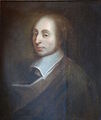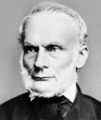Template:Selected anniversaries/August 24: Difference between revisions
No edit summary |
No edit summary |
||
| (4 intermediate revisions by the same user not shown) | |||
| Line 8: | Line 8: | ||
||1456: The printing of the Gutenberg Bible is completed. | ||1456: The printing of the Gutenberg Bible is completed. | ||
||1561: Bartholomaeus Pitiscus born . | File:Trigonometriae_-_Bartholomaeus_Pitiscus.jpg|link=Bartholomaeus Pitiscus (nonfiction)|1561: Mathematician, astronomer, and theologian [[Bartholomaeus Pitiscus (nonfiction)|Bartholomaeus Pitiscus]] born. Pitiscus will coin the word "trigonometry". | ||
||1595: Thomas Digges dies ... mathematician and astronomer. He was the first to expound the Copernican system in English but discarded the notion of a fixed shell of immoveable stars to postulate infinitely many stars at varying distances. He was also first to postulate the "dark night sky paradox". Pic: https://www.pinterest.com/pin/466967055096765851/ | ||1595: Thomas Digges dies ... mathematician and astronomer. He was the first to expound the Copernican system in English but discarded the notion of a fixed shell of immoveable stars to postulate infinitely many stars at varying distances. He was also first to postulate the "dark night sky paradox". Pic: https://www.pinterest.com/pin/466967055096765851/ | ||
| Line 34: | Line 34: | ||
||1861: Pierre Berthier dies ... mineralogist and mining engineer who discovered bauxite (aluminium ore) on 23 Mar 1821 near the village Les Baux de Provence in southern France. On 24 May 1806, he joined the central laboratory at the Board of Mines. From 1816, he was chief of the laboratory at the École des Mines, and professor of assaying. Berthier analyzed kaolin along with dozens of other minerals and ores. He sought out phosphate deposits valuable for agriculture. He published a treatise (1834) of practical analytical procedures that were widely used by other mineralogists. In another field, Berthier noticed - before Mitscherlich - that isomorphism occurred whereby chemically different substances can have the same crystalline form and even co-crystallize. Pic. | ||1861: Pierre Berthier dies ... mineralogist and mining engineer who discovered bauxite (aluminium ore) on 23 Mar 1821 near the village Les Baux de Provence in southern France. On 24 May 1806, he joined the central laboratory at the Board of Mines. From 1816, he was chief of the laboratory at the École des Mines, and professor of assaying. Berthier analyzed kaolin along with dozens of other minerals and ores. He sought out phosphate deposits valuable for agriculture. He published a treatise (1834) of practical analytical procedures that were widely used by other mineralogists. In another field, Berthier noticed - before Mitscherlich - that isomorphism occurred whereby chemically different substances can have the same crystalline form and even co-crystallize. Pic. | ||
||1875: Henry Louis Rietz born ... mathematician, actuarial scientist, and statistician, who was a leader in the development of statistical theory. Pic search | ||1875: Henry Louis Rietz born ... mathematician, actuarial scientist, and statistician, who was a leader in the development of statistical theory. Pic search. | ||
||1886: William Francis Gibbs born ... naval architect, one of the most renowned in his time, having designed over 6,000 ships from a fireboat, to freighters, ocean liners and warships. Early in his life, he began building self-taught skills by studying blueprints and existing vessels. In 1915, Gibbs and his brother Frederic H., joined the International Mercantile Marine Company, but had their own firm by 1922 which converted an ex-German liner into the American luxury liner SS Leviathan. The Gibbs firm oversaw the design of 74% of all naval vessels built during WW II, making Gibbs an outstanding contributor to the American war effort. Postwar, he realized his lifelong dream: the 1,000 foot superliner, the SS United States, the fastest ship to cross the Atlantic. Pic. | ||1886: William Francis Gibbs born ... naval architect, one of the most renowned in his time, having designed over 6,000 ships from a fireboat, to freighters, ocean liners and warships. Early in his life, he began building self-taught skills by studying blueprints and existing vessels. In 1915, Gibbs and his brother Frederic H., joined the International Mercantile Marine Company, but had their own firm by 1922 which converted an ex-German liner into the American luxury liner SS Leviathan. The Gibbs firm oversaw the design of 74% of all naval vessels built during WW II, making Gibbs an outstanding contributor to the American war effort. Postwar, he realized his lifelong dream: the 1,000 foot superliner, the SS United States, the fastest ship to cross the Atlantic. Pic. | ||
| Line 46: | Line 46: | ||
File:Thomas Edison.jpg|link=Thomas Edison (nonfiction)|1891: [[Thomas Edison (nonfiction)|Thomas Edison]] patents the motion picture camera. | File:Thomas Edison.jpg|link=Thomas Edison (nonfiction)|1891: [[Thomas Edison (nonfiction)|Thomas Edison]] patents the motion picture camera. | ||
||1893: Haim Ernst Wertheimer born ... biochemist and academic. | ||1893: Haim Ernst Wertheimer born ... biochemist and academic ... Pic search. | ||
||1894: Rudolf Oskar Robert Williams Geiger born ... meteorologist who was one of the founders of microclimatology (the study of the climatic conditions within a few metres of the ground surface). His observations, made above grassy fields or areas of crops and below forest canopies, elucidated the complex and subtle interactions between vegetation and the heat, radiation, and water balances of the air and soil. Pic: https://www.geographixs.com/koumlppen-geiger.html | ||1894: Rudolf Oskar Robert Williams Geiger born ... meteorologist who was one of the founders of microclimatology (the study of the climatic conditions within a few metres of the ground surface). His observations, made above grassy fields or areas of crops and below forest canopies, elucidated the complex and subtle interactions between vegetation and the heat, radiation, and water balances of the air and soil. Pic: https://www.geographixs.com/koumlppen-geiger.html | ||
||1899: Albert Claude born ... biologist and academic, Nobel Prize laureate. Pic. | |||
||1899: Albert Claude born ... biologist and academic, Nobel Prize laureate. | |||
File:Jorge Luis Borges.jpg|link=Jorge Luis Borges (nonfiction)|1899: Short-story writer, essayist, poet and translator [[Jorge Luis Borges (nonfiction)|Jorge Luis Borges]] born. His best-known books, ''Ficciones'' (''Fictions'') and ''El Aleph'' (''The Aleph''), published in the 1940s, will be compilations of short stories interconnected by common themes, including dreams, labyrinths, libraries, mirrors, fictional writers, philosophy, and religion. | File:Jorge Luis Borges.jpg|link=Jorge Luis Borges (nonfiction)|1899: Short-story writer, essayist, poet and translator [[Jorge Luis Borges (nonfiction)|Jorge Luis Borges]] born. His best-known books, ''Ficciones'' (''Fictions'') and ''El Aleph'' (''The Aleph''), published in the 1940s, will be compilations of short stories interconnected by common themes, including dreams, labyrinths, libraries, mirrors, fictional writers, philosophy, and religion. | ||
| Line 82: | Line 80: | ||
||1941: Adolf Hitler orders the cessation of Nazi Germany's systematic T4 euthanasia program of the mentally ill and the handicapped due to protests, although killings continue for the remainder of the war. | ||1941: Adolf Hitler orders the cessation of Nazi Germany's systematic T4 euthanasia program of the mentally ill and the handicapped due to protests, although killings continue for the remainder of the war. | ||
||1942: Jim Horning born ... computer scientist and academic. His interests included programming languages, programming methodology, specification, formal methods, digital rights management and computer/network security. A major contribution was his involvement with the Larch approach to formal specification Pic search | ||1942: Jim Horning born ... computer scientist and academic. His interests included programming languages, programming methodology, specification, formal methods, digital rights management and computer/network security. A major contribution was his involvement with the Larch approach to formal specification Pic search. | ||
||1943: Simone Weil born ... mystic and philosopher. Pic. | ||1943: Simone Weil born ... mystic and philosopher. Pic. | ||
| Line 111: | Line 109: | ||
||1990: Harold Masursky dies ... geologist and senior scientist at the U.S. Geological Survey's astrogeology branch supporting space exploration. Starting in the mid 1960s, he helped analyze the photographs from the Ranger, Lunar Orbiter, and Surveyor lunar missions. In mapping the moon, suitable landing spots were being sought for the unmanned Surveyor 5 spacecraft (1967) and the manned Apollo landings (1969-72). Masursky headed the group that interpreted television transmissions from Martian satellite Mariner 9 (1971), producing maps to plan the landing of unmanned Viking spacecraft on Mars (1976). He analyzed data on the geological origins and evolution of the planets. He collaborated in foreign projects such as the Soviet Venus probes. Pic: https://www.todayinsci.com/8/8_24.htm | ||1990: Harold Masursky dies ... geologist and senior scientist at the U.S. Geological Survey's astrogeology branch supporting space exploration. Starting in the mid 1960s, he helped analyze the photographs from the Ranger, Lunar Orbiter, and Surveyor lunar missions. In mapping the moon, suitable landing spots were being sought for the unmanned Surveyor 5 spacecraft (1967) and the manned Apollo landings (1969-72). Masursky headed the group that interpreted television transmissions from Martian satellite Mariner 9 (1971), producing maps to plan the landing of unmanned Viking spacecraft on Mars (1976). He analyzed data on the geological origins and evolution of the planets. He collaborated in foreign projects such as the Soviet Venus probes. Pic: https://www.todayinsci.com/8/8_24.htm | ||
||1993: Boris Levin dies ... mathematician who made significant contributions to function theory. Pic. | ||1993: Boris Levin dies ... mathematician who made significant contributions to function theory. Pic. | ||
| Line 121: | Line 117: | ||
||2016: Roger Yonchien Tsien (d. August 24, 2016) was an American biochemist and academic. He was awarded the 2008 Nobel Prize in Chemistry for his discovery and development of the green fluorescent protein, in collaboration with organic chemist Osamu Shimomura and neurobiologist Martin Chalfie. Pic. | ||2016: Roger Yonchien Tsien (d. August 24, 2016) was an American biochemist and academic. He was awarded the 2008 Nobel Prize in Chemistry for his discovery and development of the green fluorescent protein, in collaboration with organic chemist Osamu Shimomura and neurobiologist Martin Chalfie. Pic. | ||
</gallery> | </gallery> | ||
Latest revision as of 13:22, 7 February 2022
1561: Mathematician, astronomer, and theologian Bartholomaeus Pitiscus born. Pitiscus will coin the word "trigonometry".
1654: Blaise Pascal writes to Pierre de Fermat, describing his solution to the Problem of the Points (a probability problem) and asking Fermat to critique it.
1819: inventor, engineer, and chemist James Watt dies. He made major improvements to the steam engine.
1877: Canada grants Alexander Graham Bell a patent for the telephone.
1888: Rudolf Clausius dies. He was one of the central founders of the science of thermodynamics.
1891: Thomas Edison patents the motion picture camera.
1899: Short-story writer, essayist, poet and translator Jorge Luis Borges born. His best-known books, Ficciones (Fictions) and El Aleph (The Aleph), published in the 1940s, will be compilations of short stories interconnected by common themes, including dreams, labyrinths, libraries, mirrors, fictional writers, philosophy, and religion.
1922: Historian, playwright, and social activist Howard Zinn born. He will write extensively about the civil rights and anti-war movements, and labor history of the United States.
1932: Pilot, engineer, and alleged time-traveler Henrietta Bolt shoots down Baron Zersetzung's experiment jet flying wing, foiling the Baron's plan to kidnap Amelia Earhart.
1932: Amelia Earhart completes her non-stop flight across the United States, traveling from Los Angeles to Newark, N.J., in just over 19 hours. She was the first woman to fly nonstop across the US. Earlier in the same year, on 20 May 1932, she accomplished the first solo flight by a woman across the Atlantic Ocean.









